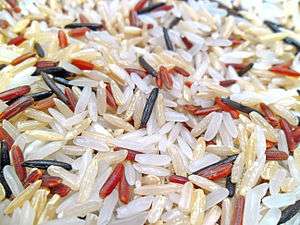Calrose rice

Calrose is a medium grain rice variety, notable for being the founding variety of the California rice industry.
History
Calrose (USDA # C.I. 8988) originated and was developed at the Rice Experiment Station near Biggs, California[1] and released to California growers in 1948.[2] It grew in popularity with growers, marketers, and consumers to become the prominent rice variety in California until the late 1970s. Specific processing and cooking properties were associated with Calrose. Over the years improved new varieties with Calrose grain cooking and processing characteristics were released. These medium-size grains were commingled with Calrose in storage and later replaced the variety in commercial production due to their superior performance at many levels. Although that variety of Calrose is no longer grown, Calrose has become a name recognized in trade and the market place for the California type medium grain rice. The name "rose" indicates medium-grain shape (Blue Rose is an earlier medium grain developed in Louisiana) and "Cal" to indicate California origin and production.
Availability
It is the most recognized variety of California rice in the United States and abroad, especially in the Pacific. In Hawaii, Guam and other islands, Calrose rice accounts for more than 90% of the rice consumed. The variety is grown in other areas of the world where growing conditions are suitable, such as Australia.
After cooking, Calrose rice grains hold flavor well, and are soft and stick together, making it good for use in sushi.
Calrose was once a much sought-after variety in parts of Asia, where it was considered exotic. There was even a black market for the variety and it was smuggled in large quantities.[3]
References
- ↑ California Cooperative Rice Research Foundation, Inc., Rice Experiment Station (RES, 955 Butte City Highway [Hwy 99], Biggs, CA 95917) http://www.plantsciences.ucdavis.edu/ricestation/ 39°27′52″N 121°44′01″W / 39.464369°N 121.733645°W
- ↑ Johnson, T.H. (1958). "Registration of Rice Varieties". Agronomy Journal. 50: 694–700. doi:10.2134/agronj1958.00021962005000110021x.
- ↑ "Imported U.S. Rice Loses Its Luster". The Chosun Ilbo. Retrieved 2 February 2014.
